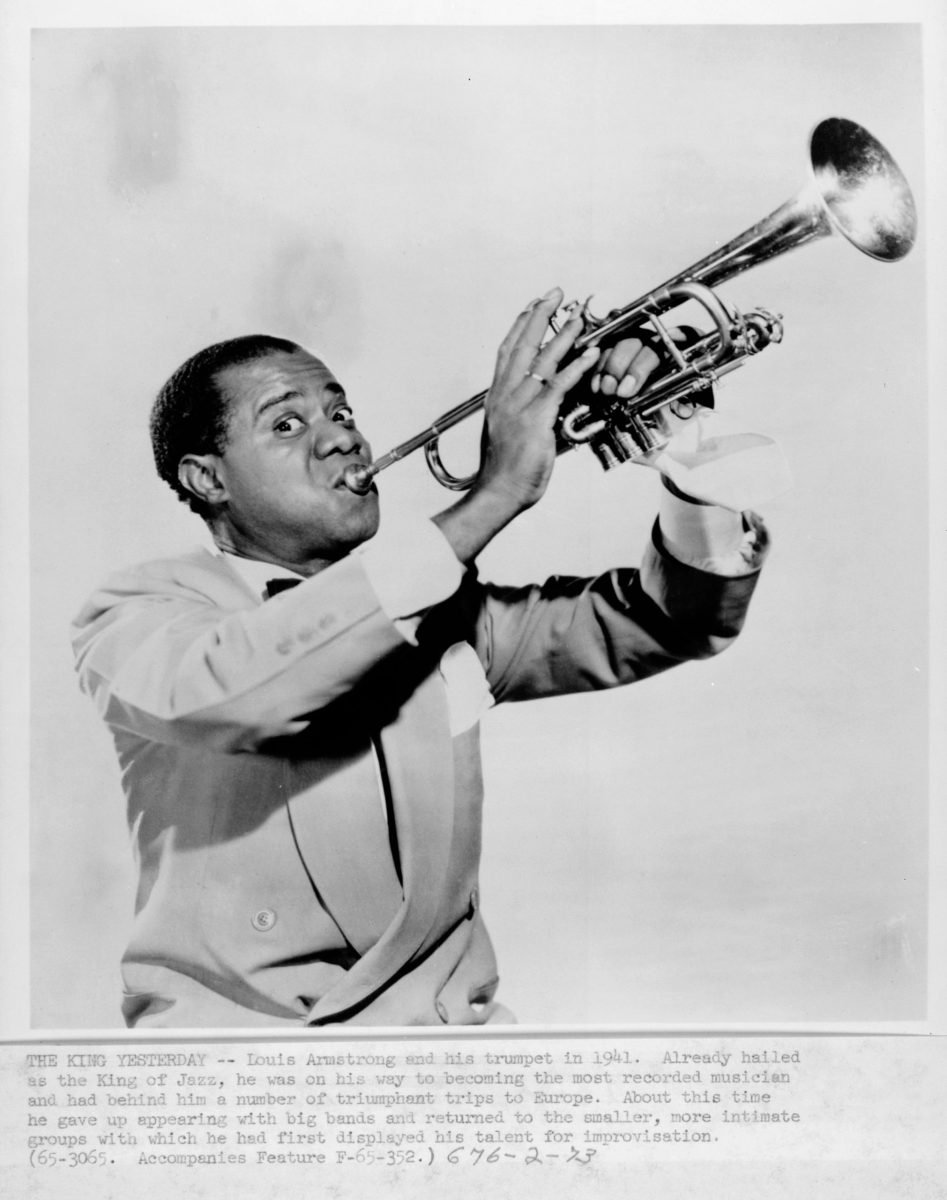February is Black History Month. Visit the National Archives website for more information on our resources related to African American history. Today’s post, from Alyssa Moore in the National Archives History Office, looks at the legendary jazz musician Louis Armstrong.

Louis Armstrong was born on August 4, 1901 (although he often claimed he was born on July 4, 1900), into a world immersed in the jazz of New Orleans’ saloons, social halls, and dance clubs. Raised largely by a single mother, Mary “Mayann” Albert, Armstrong and his younger sister spent their childhood in the “Back o’ Town” neighborhood, sometimes nicknamed “The Battlefield.” He left school after fifth grade to work for the local Karnofsky family at their tailor shop. The family encouraged him to pursue his interest in music, and Armstrong used his wages to purchase his first cornet.
Armstrong’s life changed on New Year’s Eve in 1912 when he was arrested for borrowing his stepfather’s gun without permission and firing a blank into the air. He was sent to the “Colored Waif’s Home for Boys,” a segregated reform school in New Orleans. Conditions at the Home were dire, and the head of its music program, Peter Davis, took Armstrong under his wing. Davis taught him how to properly play the cornet, and Armstrong later led the Waif’s Home Brass Band.
Armstrong was released from the home after a year and a half. Now 14 years old, he decided to pursue music professionally. Armstrong began playing in brass bands on Mississippi riverboats. There he picked up valuable skills, such as learning how to sight-read music, while playing alongside other musicians. Armstrong’s talent caught the attention of New Orleans’ top cornetist, Joe “King” Oliver. Under Oliver’s mentorship, Armstrong became one of the premier musicians in New Orleans.

In 1922, Oliver invited Armstrong to join his Creole Jazz Band in Chicago. At the time, the United States was in the full swing of the Harlem Renaissance, and the city of Chicago was booming. Armstrong’s reputation skyrocketed as he and the band started making records there in 1923. He married the band’s pianist, Lillian Hardin, in 1924. Hardin recognized Armstrong’s talent and urged him to launch a solo career as a trumpet and cornet player. In 1925, Armstrong took her advice and began making records under his own name.
He assembled Louis Armstrong and His Hot Five, which became, in 1927, His Hot Seven. In one year alone the group produced a staggering 26 records. Among these were the hits “Cornet Chop Suey,” “Struttin’ With Some Barbecue,” “Hotter Than That,” and “Potato Head Blues.”
During this era, Armstrong developed his own personal style of playing that featured improvised solos and scat vocals. While he was not the first to record scat singing, Armstrong popularized it with the first recording on which he scatted, his 1926 hit “Heebie Jeebies.” By then Armstrong was in his early 20s, but he was becoming a phenomenon. As the 1920s came to a close, he began touring and, arguably, never stopped until his death in 1971.

Throughout the 1930s, Armstrong reached audiences around the world. As he toured, he continued to gain popularity on the radio and appeared in several films. He performed in Europe for the first time in 1932 and again in 1933. Returning to the U.S. in 1935, Armstrong began touring the United States with a 16-piece big band ensemble. By 1947, though, big bands started to go out of style. Armstrong then started a small group named Louis Armstrong and His All Stars.
By the 1950s, Armstrong was a beloved American icon with an international fanbase. The Department of State sought to capitalize on Armstrong as a cultural ambassador and scheduled him to tour part of the Communist Bloc in 1965 as an unofficial goodwill ambassador with the intention of countering Communist propaganda. He was dubbed “Ambassador Satch,” after his nickname “Satchmo.”

Years of intense touring finally took its toll on Armstrong. Playing the trumpet is notoriously hard on the performer’s lips, and Armstrong suffered from lip damage for most of his life. During one of his European tours, Armstrong developed an ulceration so severe that he was forced to stop performing for a year. Eventually he began using salves and creams and also cutting off scar tissue with a razor blade.
Armstrong then suffered from his first heart attack in 1959. Despite his declining health, in 1964, Armstrong recorded his biggest-selling record, “Hello, Dolly!” It knocked The Beatles off the top of the Billboard Hot 100 chart, making Armstrong the oldest artist to have a number one song.

After receiving treatment for heart and kidney problems in 1968, his physicians advised him to take a break from playing. But Armstrong continued to practice every day in his Corona, Queens, home where he lived with his fourth wife, Lucille. In 1968, Armstrong recorded his final hit “What a Wonderful World.” He returned to live performances in 1970 and passed away in his sleep on July 6, 1971.
Today Armstrong is recognized as one of the leaders of the Harlem Renaissance, a catalyst behind the revival of African American culture in the U.S., and a pioneer who ushered in a new era of jazz music. On February 21, 1949, he was the first jazz musician to appear on the cover of Time magazine, and in 1937, when Armstrong substituted for Rudy Vallée on a CBS radio network, he became the first African American to host a sponsored, national broadcast.
He played more than 300 performances every year for 30 years. In recognition of Armstrong’s monumental legacy and lasting contribution to the genre of jazz, his home in Queens was designated a National Landmark in 1976. Today the Louis Armstrong House presents concerts and educational programs while also making its archival materials available for public research.





